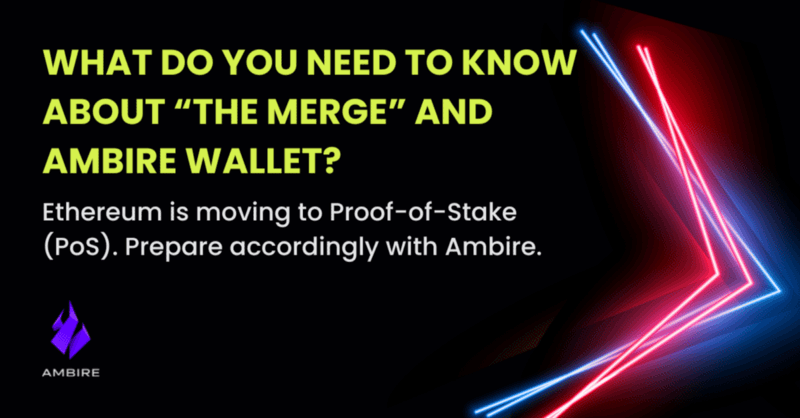"The Merge" and Ambire Wallet: What You Need to Know
Ethereum is moving to Proof-of-Stake (PoS) around September 14, 2022 becoming more secure, less energy-intensive, and ready for new scaling…

Ethereum is moving to Proof-of-Stake (PoS) around September 14, 2022 becoming more secure, less energy-intensive, and ready for new scaling solutions. Prepare accordingly with Ambire.
TLDR: Ambire will not support the ETHPoW fork out of the box, but you will able to claim your post-fork POW-ETH
The Merge is the most significant upgrade in the history of Ethereum. It represents the joining of the existing execution layer of Ethereum, the Mainnet we use today, with its new Proof-of-Stake consensus layer, the Beacon Chain with the Bellatrix upgrade. The Proof-of-Work chain will migrate to Proof-of-Stake upon hitting a specific Total Difficulty value.
Ethereum core devs agreed upon a Terminal Total Difficulty value triggering The Merge, set at 58750000000000000000000, expected between Sept 10–20, 2022.

Merging the chains
Ever since the genesis block in July 2015 we’ve been all using the Mainnet, the Proof-of-Work secured version of Ethereum, containing every transaction, smart contract, NFTs, tokens and balances so far.
However, for quite a long time Ethereum developers have been preparing the eventual transition from PoW to PoS. On December 1, 2020, the Beacon Chain was created, which has since existed as a separate blockchain to Mainnet, running in parallel.
However, the Beacon chain hasn’t been processing Мainnet transactions, but has been reaching consensus on its own state by agreeing on active validators and their account balances. The Beacon chain underwent serious testing as well. After The Merge, it will be the consensus engine for all network data, including execution layer transactions and account balances.
After The Merge, mining will no longer be the tool for producing valid blocks. Instead, the proof-of-stake validators are taking this role and will be responsible for processing the validity of all transactions and proposing blocks.
No history will be lost. Merging with the Beacon Chain, Mainnet will also merge the entire transactional history of Ethereum.

“Playing” The Merge
Okay, you already know what will happen with Mainnet and the Beacon chain, but what about the army of miners behind PoW? In long term, miners are going to be the big losers from the transition to a more powerful Ethereum, but they surely won’t give up without fighting.
It is expected that right after The Merge miners will fork ETH to keep a PoW version so they can continue mining. Forking means that the whole Ethereum before The Merge will be literally “pasted” to a new PoW version of its own.
As all Ambire fam, you are probably smart enough to figure at this point that whatever tokens you had on Mainnet before The Merge will now be on two chains at the same time — the PoS and the PoW. There must be a catch here, right?
Yes, there is. PoS is the Future of Ethereum and all participants in the ecosystem but the miners believe in it. PoS will be the “official” Ethereum after The Merge, meaning it will be supported by RPC providers, exchanges, developers, etc.
However, if theoretically miners manage to convince enough people to trade tokens or participate in some form on the PoW chain, it may live its own live as well — this has already happened in past when in 2016 Ethereum hard forked to Ethereum and Ethereum Classic.
It is very likely that PoW Ethereum will indeed have some activity at least in the beginning. People are generally greedy and everyone will try to dump their “airdropped” PoW-ETH/ERC20s. The important questions here are “Who is going to buy it?” and “At what price?”. Playing The Merge is nice, but you should consider some possible implications:
- Bots will be faster than people and most of the extractable value of the PoW ETH/ERC20s will be consumed shortly after The Merge by bots
- Replay attacks may theoretically harm your PoS ETH/ERC20s as well
- If your ETH is sitting on an exchange, you may not be getting PoW ETH/ERC20s if the exchange doesn’t support PoW after The Merge. If you want maximum exposure to the potential fork, keep your tokens on a non-custodial wallet like Ambire.
- Will Ambire support the fork? Read on to find out.
In a very good thread, Coingecko founder Bobby Ong outlined the most important strategies and steps to prepare for and play The Merge. Needless to say, this is not a financial advice and the Ambire team is not affiliated, so you should do your own research:
Ambire and The Merge
Ambire is committed to fully supporting the upgraded Ethereum PoS chain after The Merge. We believe in the PoS future of Ethereum and we are super excited about it. Let’s answer some important questions about Ambire and The Merge:
-Will Ambire support Ethereum PoS?
-Yes!
-Will Ambire support potential ETHW (PoW) fork?
-Ambire is chain-agnostic and open-source. Anyone can add a custom chain through configuring it in the source code, but it’s unlikely that ETHPoW will be added as a built-in network on Ambire. You will, of course, always be able to claim your post-fork ETHW funds.
-Will my funds be safe during The Merge if I keep them in Ambire?
-Yes. Funds will be safe. 🫡
Enthusiastic about The Merge?
Jump to our Discord server and discuss with the Ambire community. Celebrate together on our X (Twitter) page and don’t forget our Twitter Spaces, taking place every Wednesday at 17 UTC.
Interested in Ambire? Follow us:
Discord | X (Twitter) | Reddit | GitHub | Telegram | Facebook
